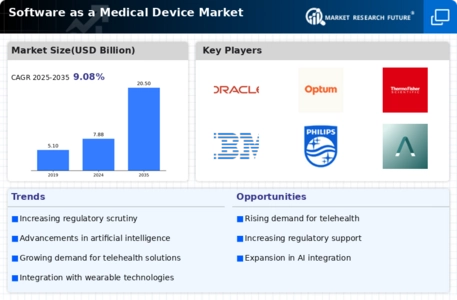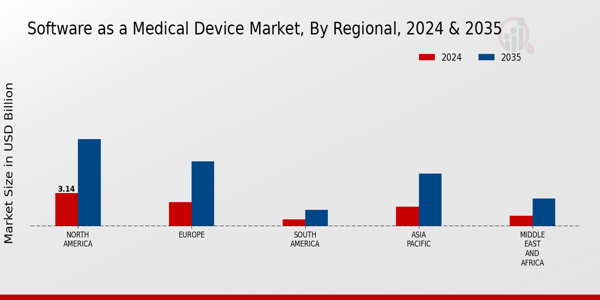Regulatory Support
Regulatory bodies worldwide are increasingly recognizing the importance of Software as a Medical Device, which is fostering a supportive environment for innovation. Initiatives aimed at streamlining the approval process for software-based medical devices are being implemented, thereby encouraging manufacturers to invest in new technologies. The Global Software as a Medical Device Market Industry benefits from these regulatory frameworks, as they provide clarity and guidance for compliance. This regulatory support is anticipated to drive market growth, with expectations of reaching 20.5 USD Billion by 2035, indicating a robust trajectory for the industry.
Technological Advancements
The Global Software as a Medical Device Market Industry is experiencing rapid technological advancements that enhance the capabilities of medical devices. Innovations in artificial intelligence, machine learning, and data analytics are enabling software solutions to provide more accurate diagnostics and personalized treatment plans. For instance, AI-driven applications are increasingly used to analyze medical imaging, leading to improved patient outcomes. This trend is expected to contribute to the market's growth, with projections indicating a market value of 7.88 USD Billion in 2024, reflecting the industry's adaptation to cutting-edge technologies.
Integration with Healthcare Systems
The integration of Software as a Medical Device with existing healthcare systems is a critical driver of growth in the Global Software as a Medical Device Market Industry. Seamless interoperability between software solutions and electronic health records enhances data sharing and improves clinical workflows. This integration not only streamlines operations but also supports better decision-making by healthcare professionals. As healthcare organizations increasingly adopt integrated solutions, the market is poised for substantial growth. The anticipated market value of 20.5 USD Billion by 2035 underscores the importance of this integration in shaping the future of medical technology.
Rising Demand for Remote Monitoring
The demand for remote monitoring solutions is surging within the Global Software as a Medical Device Market Industry. As healthcare systems increasingly prioritize patient-centered care, software solutions that facilitate remote patient monitoring are becoming essential. These tools enable healthcare providers to track patient health metrics in real-time, improving management of chronic diseases and reducing hospital readmissions. The market's growth is further supported by the increasing prevalence of chronic conditions, which necessitates continuous monitoring. This trend is likely to contribute to a compound annual growth rate of 9.08% from 2025 to 2035.
Increased Investment in Digital Health
Investment in digital health technologies is on the rise, significantly impacting the Global Software as a Medical Device Market Industry. Venture capital and public funding are increasingly directed toward innovative software solutions that improve healthcare delivery. This influx of capital supports research and development efforts, enabling companies to create advanced medical software that meets evolving healthcare needs. The market's expansion is reflected in the projected growth to 7.88 USD Billion in 2024, driven by heightened interest in digital health initiatives and the potential for improved patient outcomes.




















